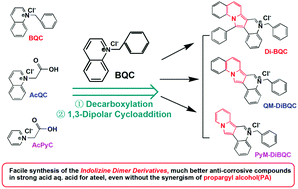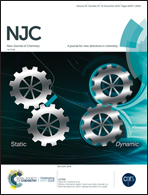Indolizine quaternary ammonium salt inhibitors, part III:† insights into the highly effective low-toxicity acid corrosion inhibitor – synthesis and protection performance
Abstract
Three indolizine derivatives (Di-BQC, QM-DiBQC, and PyM-DiBQC), which were prepared facilely in high yield via a 1,3-dipolar cycloaddition reaction, were found to exhibit good corrosion inhibition for steel in concentrated acid without the synergism of propargyl alcohol (PA). The inhibitive derivatives exhibit high protection efficiency and have eco-friendly advantages over the highly toxic PA. The accurate formulas and structures of the three compounds are characterized by high resolution mass spectrometry (HRMS) and nuclear magnetic resonance (NMR) spectroscopy. The corrosion inhibition performance of the indolizine derivatives toward N80 steel was investigated in 15 wt% HCl and 20 wt% HCl by weight loss measurements, electrochemical tests (Tafel and EIS), SEM/EDX analysis and theoretical calculations. The biological toxicity was investigated by using the Microtox toxicity test. At 90 °C, a dosage of 0.1 wt% indolizine derivatives in 15 wt% HCl would decrease the corrosion rate of N80 steel dramatically to less than 10 g m−2 h−1. While for PA, a much higher corrosion rate was observed under the same conditions, indicating that the indolizine derivatives are more effective inhibitors in contrast with PA. Results from gravimetric analysis as well as the electrochemical studies and DFT methods are in good agreement, verifying the fine corrosion prevention of the three compounds. The results of biotoxicity tests confirmed the relatively low-toxicity properties of the indolizine derivatives and the suggested inhibition mechanism was also discussed. All the conclusions above indicate that the new indolizine derivatives could be presented as highly effective acidizing inhibitors and the derivatives may offer a new enlightening strategy for corrosion protection under acidizing conditions.



 Please wait while we load your content...
Please wait while we load your content...